Are you intrigued by the potential value of 2019 Lincoln pennies? You’ve come to the right place! We’ve compiled a comprehensive list of 2019 penny errors that could be worth far more than their face value. These are the coins you should keep an eye out for.
Lincoln pennies, despite their nominal value of just one cent, hold a special place in the hearts of many collectors. Their affordability, combined with the profound historical significance of President Lincoln in shaping our nation’s destiny, makes them a popular choice for numismatists of all levels.
While uncirculated Lincoln pennies can command a premium, it’s the rare minting errors that often prove to be the most lucrative finds. These unusual coins can fetch prices well above their face value, making them prized additions to any collection.
Whether you’re a novice just starting your journey into penny collecting or a seasoned enthusiast, understanding what to look for in these ubiquitous coins can greatly enhance your collecting experience.
Let’s dive into our curated list of 2019 penny errors and explore the most valuable Lincoln penny anomalies that could be hiding in your change or waiting to be discovered at your local coin shop.
1. 2019 Lincoln Penny Retained Interior Die Break Reverse Error
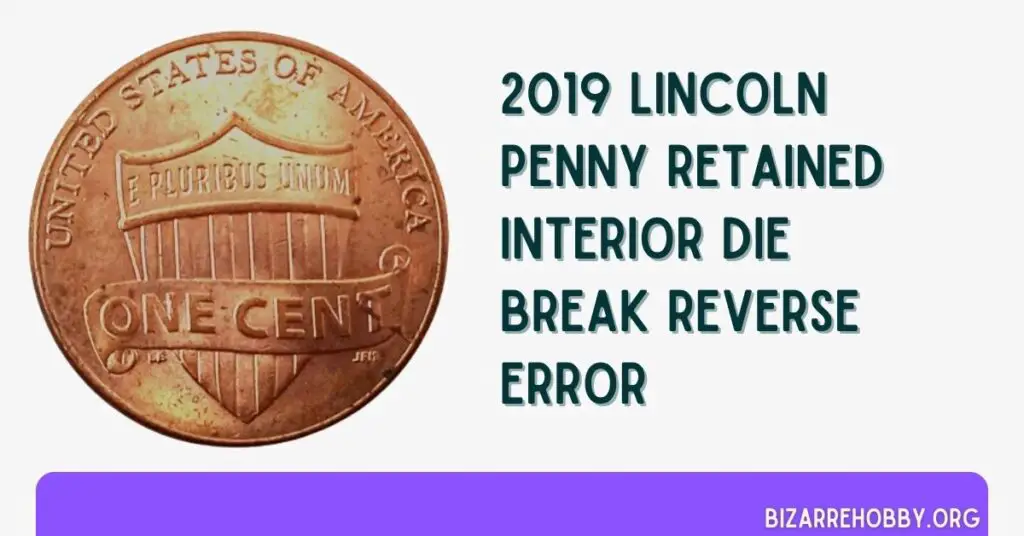
One of the most striking errors found on 2019 Lincoln pennies is the retained interior die break. This fascinating defect occurs when a substantial chunk of metal flakes off the die’s surface, creating a void. However, if this metal fragment doesn’t completely detach, it results in what’s known as an interior die break. Often, these interior breaks are linked to a die crack that extends to the coin’s edge.
For collectors focusing on 2019 pennies, it’s particularly worthwhile to examine the reverse side for this error. A common location for the retained interior die break is above the letter “T” in “ONE CENT”. This intriguing flaw can significantly increase the coin’s value, with specimens typically fetching between $15 and $20, depending on the overall condition of the penny.
The appeal of this error lies not only in its visual distinctiveness but also in its relatively accessible price point for collectors. It offers an excellent opportunity to add a unique and valuable piece to your collection without breaking the bank.
2. 2019 Lincoln Penny Off Center Error
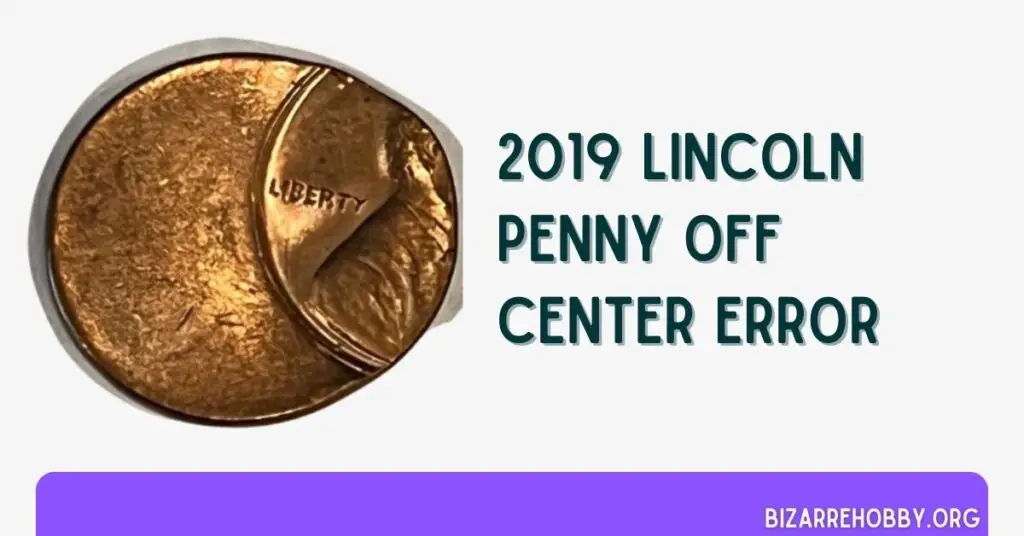
When sifting through 2019 pennies, keep an eye out for the intriguing off-center error. This distinctive flaw occurs when the coin’s design is struck away from its intended central position. Such misalignment can result from the planchet shifting within the collar or from improperly aligned dies during the minting process.
The value of an off-center error coin is directly proportional to the degree of misalignment. Generally, the further off-center the strike, the more valuable the coin becomes. For instance, a penny with a 10% off-center strike would typically command a higher price than one with only a 5% misalignment, assuming all other factors are equal.
Some 2019 Lincoln pennies exhibit this error on the reverse side, with the shield design noticeably off-center. These coins often display a broad strike error as well, where one side of the coin appears slightly larger in diameter than the other.
For collectors, these off-center error pennies represent an affordable entry point into the world of numismatic rarities. You can expect to pay around $18 for a circulated specimen, while uncirculated examples may fetch up to $40. This price range makes them an attractive option for both novice and experienced collectors looking to add a unique piece to their collection without a significant investment.
3. 2019 Lincoln Cent Die Cud Error
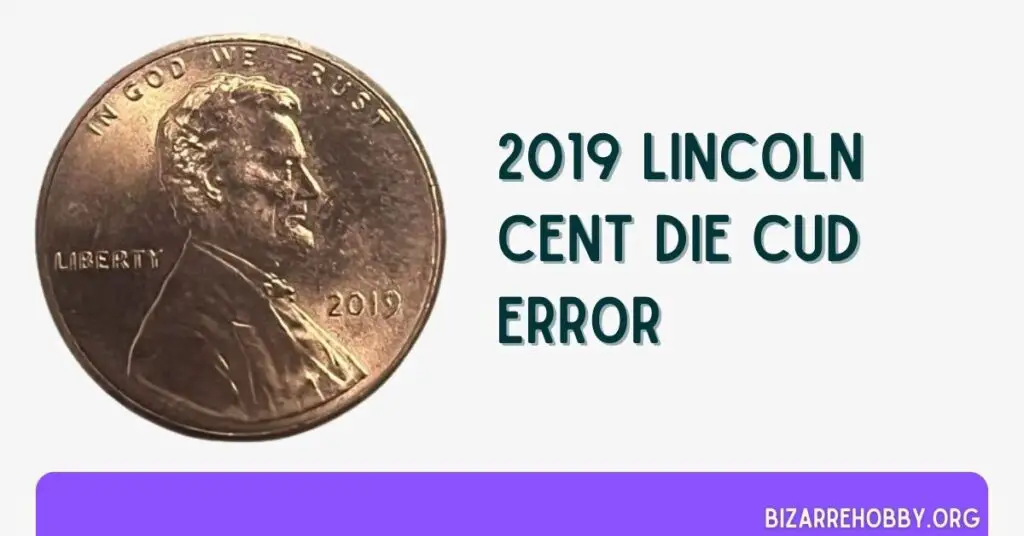
Die cuds are subtle yet intriguing errors that can be found on 2019 Lincoln pennies. These flaws share similarities with die cracks but are distinct in their formation. A cud error develops when a small fragment of the die’s surface breaks away, leaving a void in the minting surface.
The resulting error on the coin can take different forms. In some cases, the void fills with metal during the striking process, creating a raised line or bump on the coin’s surface. This elevated area corresponds to the missing section of the die.
When examining 2019 pennies, it’s worth scrutinizing both the obverse and reverse sides for these die cud errors. A notable example of this error type can be found on the obverse side of some 2019 pennies. In these instances, a die cud appears to the left of Lincoln’s truncated profile, adjacent to the date.
Despite their small size, these errors can significantly enhance a coin’s value. For instance, a 2019 penny featuring the aforementioned obverse die cud sold for $10 – a substantial premium over the face value of a circulated penny. This price point makes die cud errors an accessible and rewarding find for collectors of all levels.
The appeal of die cud errors lies not only in their increased monetary value but also in the unique story they tell about the minting process. Each cud is a tiny snapshot of wear and tear on the dies, offering collectors a tangible connection to the coin production journey.
4. 2019 Penny With Reverse Strike Through Error on Letters
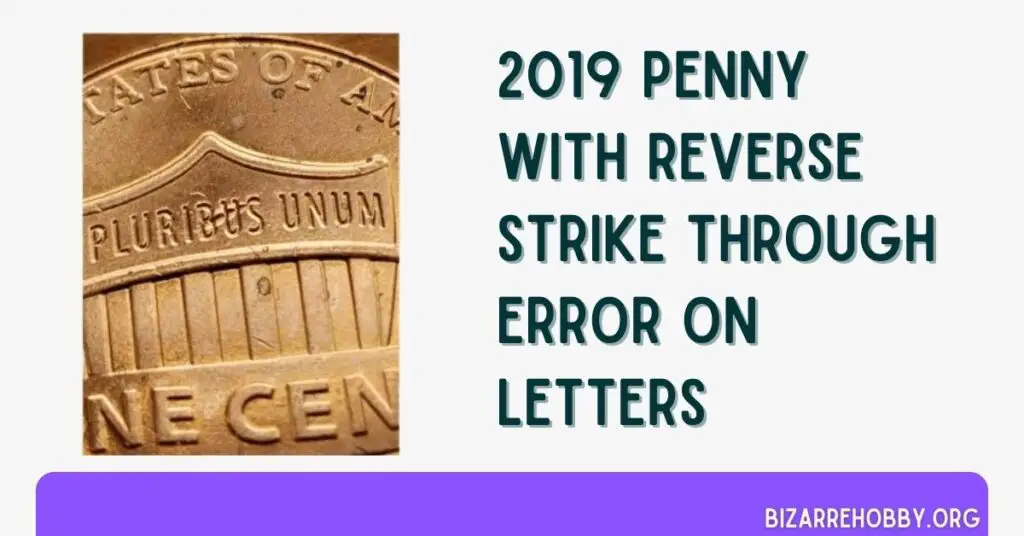
Among the intriguing flaws found on 2019 Lincoln pennies is the distinctive strike-through error. This particular defect is most notably observed on the reverse side of the coin, manifesting as what appears to be a cut or slash across the letters “BU” in the phrase “E PLURIBUS.”
Strike-through errors occur when a foreign object interferes with the minting process. This could be something as minor as a speck of dust, a small piece of debris, or even a smear of grease that finds its way between the die and the planchet during striking. The result is a unique impression left on the finished coin, often appearing as an indentation or unusual mark.
For 2019 Lincoln pennies, the most frequently encountered strike-through error is the one affecting the “BU” letters on the reverse. This specific flaw has caught the attention of collectors and numismatists alike, leading to a significant increase in the coin’s value.
The market for these error coins varies based on their condition. Circulated examples with this strike-through error have been known to sell for around $5, which is already a substantial premium over face value. However, for those lucky enough to find uncirculated or mint state specimens featuring this error, the value can soar to as much as $30.
This range in pricing makes strike-through error pennies an appealing target for collectors at various levels. Whether you’re a casual collector or a dedicated numismatist, these coins offer an opportunity to own a piece with a unique story and increased value, all stemming from a tiny mishap in the minting process.
5. 2019 Lincoln Cent With a Doubled Die Obverse Error
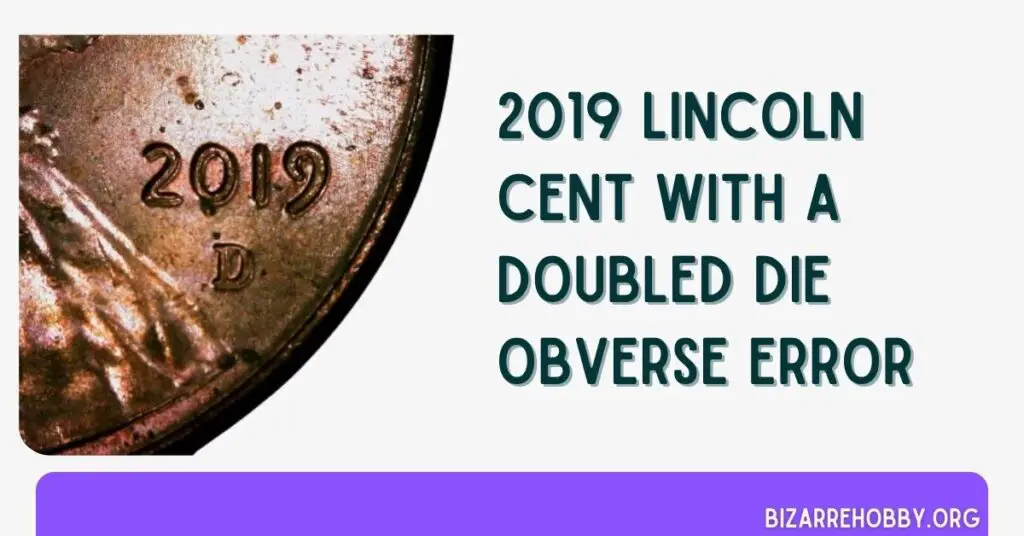
Doubled die errors are among the most well-known and sought-after coin anomalies, and the 2019 Lincoln penny is no exception. This error occurs during the die creation process, not during the actual striking of the coin. When the hub imprints the design onto the die multiple times at slightly different angles, it results in a doubled appearance on the coins struck by that die.
On 2019 Lincoln pennies, these doubled die errors can manifest in various ways. On the obverse side, collectors might spot doubling on Lincoln’s bowtie, facial features, or even the portrait outline. The lettering and date can also exhibit this doubling effect. The reverse side isn’t immune either, with doubling sometimes visible on the text, though it’s less common to see doubling on the shield elements.
The value of these doubled die pennies can vary significantly based on two primary factors: the intensity of the doubling and the coin’s overall condition. Generally, stronger or more pronounced doubling commands higher prices. Collectors can expect to pay anywhere from $50 to $100 for these error coins, with particularly striking examples or those in pristine condition potentially fetching even more.
This price range makes doubled die errors an attractive target for both novice and experienced collectors. They offer a tangible piece of minting history and a visually interesting anomaly that can be appreciated with the naked eye or a simple magnifying glass.
For those interested in acquiring these coins, it’s worth noting that the doubling can sometimes be subtle. Careful examination, preferably with a magnifying glass, is often necessary to confirm the presence and extent of the error. This hunt for doubled dies adds an element of excitement to coin collecting, turning each 2019 penny into a potential treasure.
6. 2019 Plating Blisters Lincoln Pennies Error
Plating blister errors are a fascinating and relatively common flaw found on copper-plated zinc pennies, including those minted in 2019. These errors manifest as small, bubble-like protrusions on the coin’s surface, giving the appearance of tiny air pockets on either the obverse or reverse side.
The cause of these plating blisters is rooted in the coin’s composition and minting process. Lincoln pennies produced since 1982 consist of a zinc core with a thin copper plating. Under certain conditions, such as excessive pressure or heat during the minting process, this copper plating can separate slightly from the zinc core. This separation creates small pockets where foreign particles or air can become trapped, resulting in the characteristic blister-like appearance.
On 2019 Lincoln pennies, collectors may observe these plating blisters as small, raised areas that disrupt the otherwise smooth surface of the coin. They can vary in size and number, with some coins displaying multiple blisters while others may have just one or two notable examples.
The value of coins with plating blister errors can be surprisingly high, considering the relative simplicity of the flaw. For instance, a 2019 Lincoln penny featuring a prominent plating blister has been known to sell for around $30. This represents a significant premium over the coin’s face value and even surpasses the value of many other common error types.
For collectors, these plating blister errors offer an intriguing glimpse into the complexities of the minting process. They also present an opportunity to add a visually striking and valuable piece to their collection without necessarily breaking the bank. When examining 2019 pennies, it’s worth taking a close look at the surface texture, as these small imperfections could potentially be worth much more than the penny’s face value.
7. 2019 Lincoln Penny Strike Through Grease Error

Grease strike-through errors are an intriguing type of minting flaw that can be found on 2019 Lincoln pennies. These errors occur when small amounts of grease or lubricant, used to maintain the minting machinery, inadvertently come between the die and the planchet during the striking process.
The result of this interference is a partial or complete absence of design elements on the affected area of the coin. On 2019 pennies, this can manifest in various ways, creating unique and collectible specimens.
When examining 2019 pennies for this error, look for areas where the design appears smudged, faded, or completely missing. These imperfections can occur on either the obverse or reverse side of the coin. The extent of the missing design can vary greatly, from small, barely noticeable areas to larger, more prominent blank spaces.
One notable example of this error type on a 2019 penny featured a significant grease strike-through on the obverse. In this case, Lincoln’s face and part of the date appeared smudged or partially obscured, as if someone had attempted to erase those elements. This particular coin, graded in Mint State 60 condition (MS60), sold for $25 – a considerable premium over its face value.
The value of grease strike-through errors can vary widely depending on the severity and location of the flaw, as well as the overall condition of the coin. Generally, more dramatic or unusual strike-throughs will command higher prices.
For collectors, these errors offer a fascinating glimpse into the minting process and its potential for imperfection. They also present an opportunity to own a unique piece of numismatic history. When searching through 2019 pennies, pay close attention to any areas that seem unusually smooth or lacking in detail – you might just have a valuable grease strike-through error in your hands.
8. 2019 Penny Letter on Rim Error
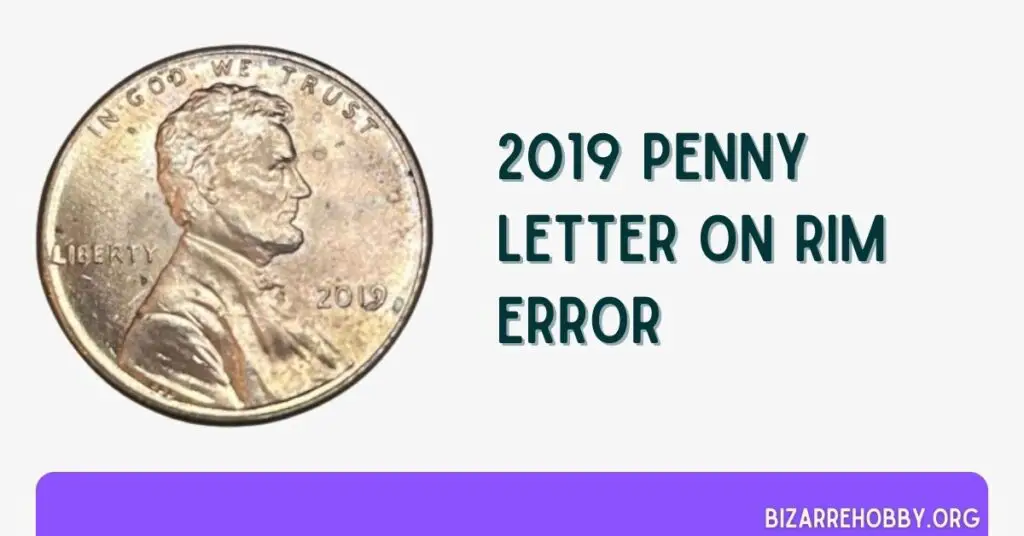
The letter-on-rim error is a striking and relatively uncommon flaw that can be found on some 2019 Lincoln pennies. This error occurs when parts of the coin’s lettering are struck outside their intended position, appearing either partially or fully on the rim of the coin instead of within its main field.
In the case of 2019 pennies, this error has been observed affecting specific letters in prominent words. On the obverse side, the ‘L’ in ‘LIBERTY’ may be found riding the rim. Similarly, on the reverse, the ‘A’ in ‘AMERICA’ has been spotted straddling or completely on the coin’s edge.
This misplacement of letters results from a misalignment during the minting process. Typically, it occurs when there’s an improper positioning of the hammer die relative to the planchet (the blank coin). This misalignment causes the design to be struck off-center, pushing some elements onto or over the rim.
The visual impact of this error can be quite dramatic, especially given the importance of the affected words to the coin’s overall design and symbolism. It’s a clear and easily noticeable deviation from the intended layout, making it appealing to error coin collectors.
The value of these letter-on-rim error coins can be substantial. A 2019 penny exhibiting this flaw has been known to sell for around $100 – a remarkable premium over its face value. This high valuation reflects both the error’s visual appeal and its relative scarcity.
For collectors of Lincoln pennies or error coins in general, a 2019 penny with a letter-on-rim error represents a prized addition to any collection. It offers a tangible example of the complexities involved in coin production and the unique results that can occur when the process goes slightly awry.
When examining 2019 pennies, pay close attention to the positioning of the lettering, particularly around the edges of the coin. A letter that seems to be “climbing” onto the rim could potentially be a valuable find, turning a common cent into a numismatic treasure.
9. 2019 Lincoln Penny Split Platting
Split plating errors are an intriguing flaw found on some 2019 Lincoln pennies, stemming from the coin’s composition of a zinc core with a thin copper plating. This error occurs when the copper plating becomes stretched beyond its limits during the minting process, causing it to separate or “split” from the underlying zinc core.
The most common manifestation of this error is around the rim of the penny. Here, the copper plating may pull away, revealing the silvery-colored zinc beneath. This creates a distinctive appearance where the edge of the coin looks worn or distressed, even on otherwise uncirculated specimens.
In some cases, the split plating can also affect other parts of the coin’s design. The edges of letters or other raised elements may show signs of separation, with the copper plating pulling away and exposing the zinc underneath. This can give these design elements a peculiar, outlined appearance.
What makes this error particularly interesting is that it can give a brand new, uncirculated coin the appearance of being well-worn. The contrast between the exposed zinc and the remaining copper plating creates a unique visual effect that stands out to collectors.
For numismatists and error coin enthusiasts, 2019 Lincoln pennies with split plating errors represent an attractive find. These coins typically command a value between $10 and $20, depending on the extent and location of the plating separation. This represents a significant premium over the coin’s face value and makes them a worthwhile addition to any collection focused on modern minting errors.
When examining 2019 pennies, pay close attention to the rim and the edges of the lettering. Any silvery appearances or areas where the copper seems to be peeling away could indicate a valuable split plating error. Remember, these coins should otherwise appear new – the “wear” is limited to the areas affected by the plating separation.
10. 2019 Lincoln “Assassination’’ Penny Error
The “assassination” penny error is a striking and somewhat macabre anomaly found on some 2019 Lincoln pennies. This unique error gets its name from its eerie resemblance to the tragic event in American history.
This error manifests as a die crack that runs from the left edge of the coin, through Lincoln’s head, and exits through his forehead. The positioning and trajectory of this crack create an unsettling illusion that mimics the path a bullet might take, hence the “assassination” moniker.
Die cracks occur when the die used to strike the coins develops a small fissure or crack. As the die continues to be used, this imperfection is transferred onto the coins it strikes, appearing as a raised line on the finished product.
What makes the “assassination” error particularly intriguing is its specificity to Lincoln pennies and its uncanny alignment with historical events. It’s important to note that this is purely coincidental – the result of random die wear rather than any intentional design.
For collectors of 2019 Lincoln pennies, the “assassination” error presents an accessible and fascinating addition to their collections. This error is relatively common within the 2019 series, making it easier for enthusiasts to acquire compared to some rarer minting mistakes.
The value of these error coins can vary, but they generally command a notable premium over face value. For instance, an “assassination” error penny from 2019, graded MS58 (About Uncirculated), has been known to sell for around $20. This price point makes it an attractive option for both novice and experienced collectors looking to add an interesting conversation piece to their collection.
When examining 2019 pennies, look closely at Lincoln’s portrait, particularly the area from the left rim through his head. A thin, raised line following this path could indicate you’ve found an “assassination” error penny. Remember, while the name of this error is attention-grabbing, it’s important to approach it with sensitivity given its historical connotations.
11. 2019 Lincoln Penny With Weak Strike Error
Weak strike errors, while not as prevalent as some other minting flaws, can be found on a number of 2019 Lincoln pennies. This error type provides an interesting insight into the minting process and can be a valuable addition to any coin collection.
As the name suggests, a weak strike error occurs when insufficient pressure is applied during the coin striking process. This can happen when the die doesn’t make full contact with the planchet, or when the striking pressure is lower than intended. The result is a coin where some or all of the design elements appear faint, shallow, or incomplete.
On 2019 Lincoln pennies, this error might manifest in various ways. You might notice areas where the details of Lincoln’s portrait are less defined, or where the lettering appears fainter than usual. In some cases, the weak strike might affect the entire coin, while in others, it might be more pronounced in certain areas.
What makes weak strike errors particularly intriguing is that they can vary significantly from one coin to another. The degree of weakness and the affected areas can differ, creating unique specimens that appeal to error coin enthusiasts.
For collectors, 2019 Lincoln pennies with weak strike errors represent a valuable find. These coins typically fetch between $50 and $80, with the exact price depending on factors such as the extent of the weak strike and the overall condition of the coin. This significant premium over face value makes them an attractive target for both casual collectors and serious numismatists.
When examining 2019 pennies for weak strikes, pay close attention to the depth and clarity of the design elements. Compare suspicious coins with normal specimens to spot differences in relief and detail. Remember that weak strikes can sometimes be confused with worn coins, so it’s important to look for other indicators of circulation wear to distinguish between the two.
While not as immediately noticeable as some other errors, weak strike pennies offer a subtle yet valuable variation for collectors interested in the intricacies of the minting process.
Final Thoughts
Your 2019 penny errors list demonstrates the wide array of intriguing variations available to collectors. This diversity offers numerous opportunities for both novice and experienced numismatists to enhance their collections with unique and valuable pieces.
One of the most appealing aspects of collecting 2019 Lincoln penny errors is the accessibility. Many of these errors can be acquired without significant financial investment, making it an approachable hobby for collectors at various levels. From retained interior die breaks to off-center strikes, there’s something to suit different interests and budgets.
However, as with any collecting pursuit, strategy is key. Focusing on uncirculated specimens with rare errors is indeed a wise approach. These coins often command the highest premiums and have the greatest potential for appreciation over time. Uncirculated coins with notable errors represent the perfect intersection of condition and uniqueness that many collectors seek.
It’s worth noting that the hunt for these errors can be as rewarding as the acquisition itself. Carefully examining pennies for subtle flaws like weak strikes or die cuds can sharpen your observational skills and deepen your understanding of the minting process.
Remember that while some errors like doubled dies or off-center strikes may be more immediately noticeable, others like split plating or subtle die cracks might require closer inspection. This variety ensures that coin collecting remains an engaging and educational pursuit.
Ultimately, whether you’re drawn to the historical significance of the Lincoln penny, fascinated by the technical aspects of minting errors, or simply enjoy the thrill of the hunt, collecting 2019 penny errors offers a rich and rewarding experience. It’s a hobby that combines the potential for financial gain with the joy of preserving and studying these tiny pieces of American history.
